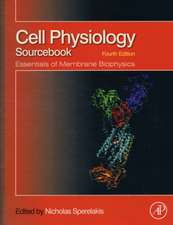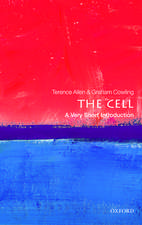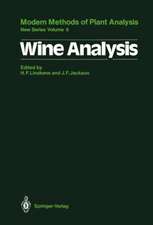Cell Components: Molecular Methods of Plant Analysis, cartea 1
Editat de Hans-Ferdinand Linskens Contribuţii de J.M. Anderson Editat de John F. Jackson Contribuţii de B. Anderson, G.A. Berkowitz, K. Cline, M. Gibbs, R. Goldberg, T. Hirokawa, A.H.C. Huang, J.F. Jackson, R.L. Jones, B. A. Larkins, Ch. Larsson, J.M. Miernyk, G. Nagahashi, Ch. Paech, D.D. Sabnis, H. Takeda, S.S. Thayer, G. Wagneren Limba Engleză Paperback – iul 2012
Din seria Molecular Methods of Plant Analysis
- 15%
 Preț: 648.42 lei
Preț: 648.42 lei - 15%
 Preț: 643.16 lei
Preț: 643.16 lei - 18%
 Preț: 896.84 lei
Preț: 896.84 lei - 18%
 Preț: 1228.77 lei
Preț: 1228.77 lei - 15%
 Preț: 642.36 lei
Preț: 642.36 lei - 15%
 Preț: 638.57 lei
Preț: 638.57 lei - 15%
 Preț: 636.12 lei
Preț: 636.12 lei - 15%
 Preț: 637.13 lei
Preț: 637.13 lei - 15%
 Preț: 634.68 lei
Preț: 634.68 lei - 18%
 Preț: 950.33 lei
Preț: 950.33 lei - 15%
 Preț: 637.93 lei
Preț: 637.93 lei - 18%
 Preț: 947.50 lei
Preț: 947.50 lei - 18%
 Preț: 950.33 lei
Preț: 950.33 lei - 18%
 Preț: 1219.01 lei
Preț: 1219.01 lei - 18%
 Preț: 1219.31 lei
Preț: 1219.31 lei - 15%
 Preț: 643.99 lei
Preț: 643.99 lei - 15%
 Preț: 641.71 lei
Preț: 641.71 lei - 15%
 Preț: 641.03 lei
Preț: 641.03 lei - 15%
 Preț: 648.24 lei
Preț: 648.24 lei - 15%
 Preț: 645.60 lei
Preț: 645.60 lei -
 Preț: 399.67 lei
Preț: 399.67 lei - 15%
 Preț: 647.08 lei
Preț: 647.08 lei
Preț: 649.54 lei
Preț vechi: 764.17 lei
-15% Nou
Puncte Express: 974
Preț estimativ în valută:
124.29€ • 129.77$ • 102.86£
124.29€ • 129.77$ • 102.86£
Carte tipărită la comandă
Livrare economică 04-18 aprilie
Preluare comenzi: 021 569.72.76
Specificații
ISBN-13: 9783642825897
ISBN-10: 3642825893
Pagini: 424
Ilustrații: XX, 399 p.
Dimensiuni: 170 x 244 x 22 mm
Greutate: 0.67 kg
Ediția:Softcover reprint of the original 1st ed. 1985
Editura: Springer Berlin, Heidelberg
Colecția Springer
Seria Molecular Methods of Plant Analysis
Locul publicării:Berlin, Heidelberg, Germany
ISBN-10: 3642825893
Pagini: 424
Ilustrații: XX, 399 p.
Dimensiuni: 170 x 244 x 22 mm
Greutate: 0.67 kg
Ediția:Softcover reprint of the original 1st ed. 1985
Editura: Springer Berlin, Heidelberg
Colecția Springer
Seria Molecular Methods of Plant Analysis
Locul publicării:Berlin, Heidelberg, Germany
Public țintă
Professional/practitionerCuprins
Cell-Wall-Isolation, General Growth Aspects.- 1 Introduction.- 2 Isolation Procedures.- 3 Composition and Ultrastructure of Plant Cell Walls.- 4 Properties of Plant Cell Walls.- 5 Growth Aspects.- References.- Cell-Wall Chemistry, Structure and Components.- 1 Introduction.- 2 Histochemical Analysis of Cell Walls.- 3 Quantitative Analysis of Cell Walls.- 4 Qualitative Analysis of Cell-Wall Materials.- 5 Chromatographic Analysis of Cell-Wall Constituents.- References.- Protoplasts—for Compartmentation Studies.- 1 Introduction.- 2 Advantages of the Use of Protoplasts for Compartmentation Studies.- 3 Protoplast Isolation and Its Effect on Cellular Metabolism.- 4 Protoplast Lysis.- 5 Protoplast Fractionation.- 6 Methods to Relate Protoplast Activity to That of Intact Tissue.- 7 Concluding Remarks.- References.- The Marker Concept in Cell Fractionation.- 1 Introduction.- 2 The Marker Concept.- 3 Preservation of Marker Enzyme Activity During Cell Disruption.- 4 Methods Used to Separate Markers.- 5 Concluding Remarks.- References.- Plasma Membranes.- 1 Introduction.- 2 Theory of Phase Partition.- 3 Experimentals.- 4 Purity of the Preparations.- 5 Protein and Lipid Composition.- 6 Surface Properties of the Isolated Vesicles.- References.- Vacuoles.- 1 Introduction.- 2 Methods of Isolation.- 3 Isolation of Tonoplast and Tonoplast Markers.- 4 Comments on Physiological Functions.- 5 Concluding Remarks.- References.- Protein Bodies.- 1 Introduction.- 2 Special Consideration in Isolation of Protein Bodies.- 3 Nonaqueous Preparation in Glycerol.- 4 Nonaqueous Preparation in Hexane and Carbon Tetrachloride.- 5 Aqueous Preparation in Sources Gradients.- 6 Subfractionation of Isolated Protein Bodies.- 7 Analyses.- References.- Lipid Bodies.- 1 Introduction.- 2 Ontogeny.- 3 Isolation.-4 Markers of Lipid Bodies.- 5 Assays.- References.- Chloroplasts as a Whole.- 1 Introduction.- 2 Considerations of Integrity and Purity.- 3 Chloroplasts from Protoplasts.- 4 The Use of Silica Sols in Density Gradient Purification of Chloroplasts.- 5 General Notes on Isolation Procedures.- 6 Specific Isolation Protocols.- 7 Additional Comments on Chloroplast Isolation.- 8 Abbreviations.- References.- Purification of Inner and Outer Chloroplast Envelope Membranes.- 1 Introduction.- 2 General Considerations.- 3 The Procedure.- 4 Properties of the Isolated Membranes.- 5 Modifications of the Procedure.- 6 Other Procedures.- References.- The Major Protein of Chloroplast Stroma, Ribulosebisphosphate Carboxylase.- 1 Introduction.- 2 Characteristics of RuBP Carboxylase.- 3 Practical Aspects.- 4 Conclusion.- References.- The Chloroplast Thylakoid Membrane—Isolation, Subfractionation and Purification of Its Supramolecular Complexes.- 1 Introduction.- 2 Function and Organization of the Thylakoid Membrane.- 3 Isolation of Thylakoid Membranes.- 4 Thylakoid Membrane Subfractionation.- 5 Isolation of Thylakoid Supramolecular Complexes.- References.- The Isolation and Characterization of Nongreen Plastids.- 1 Introduction.- 2 The Terminology of Nongreen Plastids.- 3 Basics of Plastid Isolation and Separation.- 4 Isolation of Nongreen Plastids from Developing Ricinus Endosperm.- 5 Metabolic Capabilities of Ricinus Endosperm Plastids.- 6 Composition and Biochemical Properties.- 7 Future Prospects.- References.- Mitochondria.- 1 Introduction.- 2 Preparation for DNA Analysis.- 3 Preparation of Intact Mitochondria for Oxidative Studies.- References.- Endoplasmic Reticulum.- 1 Introduction.- 2 Structure and Organization of the ER.- 3 Interactions Between Tubular and Cisternal ER.- 4Synthesis and Degradation of ER.- 5 Isolation and Characterization of ER.- References.- Polyribosomes.- 1 Introduction.- 2 Isolation of Polysomes from Plant Cells.- 3 Purification and Analysis of Polyribosomes.- 4 Polyribosome Extraction Buffers.- 5 Uses of Purified Polyribosomes.- References.- The Nucleus—Cytological Methods and Isolation for Biochemical Studies.- 1 Introduction.- 2 Structure of the Plant Nucleus and Implications for Nuclear Isolation and Staining.- 3 Cytology.- 4 Isolation of Plant Nuclei—General.- 5 Summary.- References.- Microtubules.- 1 Introduction.- 2 Extraction of Microtubule Proteins.- 3 Purification of Tubulin and MAP’s.- 4 Fractionation and Identification of Tubulin by SDS-PAGE.- 5 Colchicine-Binding Assay for Tubulin.- 6 Immunochemical Methods of Analysis.- 7 Concluding Remarks.- References.








